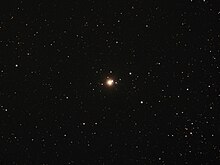Eta Persei
 From Wikipedia the free encyclopedia
From Wikipedia the free encyclopedia
| Observation data Epoch J2000 Equinox J2000 | |
|---|---|
| Constellation | Perseus |
| Right ascension | 02h 50m 41.810s[1] |
| Declination | +55° 53′ 43.80″[1] |
| Apparent magnitude (V) | 3.79[2] |
| Characteristics | |
| Spectral type | K3 Ib[3] |
| U−B color index | +1.90[2] |
| B−V color index | +1.69[2] |
| Astrometry | |
| Radial velocity (Rv) | −1.07±0.27[4] km/s |
| Proper motion (μ) | RA: +16.346 mas/yr[1] Dec.: −13.518 mas/yr[1] |
| Parallax (π) | 3.2657 ± 0.1873 mas[1] |
| Distance | 1,000 ± 60 ly (310 ± 20 pc) |
| Absolute magnitude (MV) | −4.29[5] |
| Details | |
| Radius | 173.1+9.69 −10.8[6] R☉ |
| Luminosity | 7,508±864[6] L☉ |
| Surface gravity (log g) | 0.26[6] cgs |
| Temperature | 4082±30[6] K |
| Rotational velocity (v sin i) | 5.8[3] km/s |
| Other designations | |
| Database references | |
| SIMBAD | data |
Eta Persei (η Persei, abbreviated Eta Per, η Per), is a binary star and the 'A' component of a triple star system (the 'B' component is the star HD 237009)[7] in the constellation of Perseus. Parallax measurements by the Gaia spacecraft imply that it is 1,000 is light-years away from Earth.[1] At such distance, interstellar dust diminishes its apparent brightness by 0.47 magnitudes.[6]
The two components of Eta Persei itself are designated Eta Persei A (officially named Miram /ˈmaɪræm/, a recent name for the system)[8] and B.
Nomenclature[edit]

η Persei (Latinised to Eta Persei) is the binary star's Bayer designation. The designations of its two components as Eta Persei A and B derive from the convention used by the Washington Multiplicity Catalog (WMC) for multiple star systems, and adopted by the International Astronomical Union (IAU).[9]
Eta Persei mysteriously gained the named Miram in the 20th Century, though no source is known.[10][11] In 2016, the IAU organized a Working Group on Star Names (WGSN)[12] to catalog and standardize proper names for stars. The WGSN decided to attribute proper names to individual stars rather than entire multiple systems.[13] It approved the name Miram for the component Eta Persei A on 5 September 2017 and it is now so included in the List of IAU-approved Star Names.[8]
This star, together with Delta Persei, Psi Persei, Sigma Persei, Alpha Persei and Gamma Persei has been called the Segment of Perseus.[11]
In Chinese, 天船 (Tiān Chuán), meaning Celestial Boat, refers to an asterism consisting of Eta Persei, Gamma Persei, Alpha Persei, Psi Persei, Delta Persei, 48 Persei, Mu Persei and HD 27084. Consequently, the Chinese name for Eta Persei itself is 天船一 (Tiān Chuán yī, English: the First Star of Celestial Boat.)[14]
Properties[edit]
The primary star (η Persei A) has a spectral classification of K3 Ib,[3] meaning that it is a lower luminosity supergiant star. It has expanded to 170 times the Sun's size and currently is emitting 7,500 times its luminosity. Its surface has a cool effective temperature of 4,082 K,[6] which is cooler than the Sun and gives it a orange hue, typical of K-type stars.[15]
References[edit]
- ^ a b c d e Vallenari, A.; et al. (Gaia collaboration) (2023). "Gaia Data Release 3. Summary of the content and survey properties". Astronomy and Astrophysics. 674: A1. arXiv:2208.00211. Bibcode:2023A&A...674A...1G. doi:10.1051/0004-6361/202243940. S2CID 244398875. Gaia DR3 record for this source at VizieR.
- ^ a b c Ducati, J. R. (2002). "VizieR Online Data Catalog: Catalogue of Stellar Photometry in Johnson's 11-color system". CDS/ADC Collection of Electronic Catalogues. 2237. Bibcode:2002yCat.2237....0D.
- ^ a b c De Medeiros, J. R.; Udry, S.; Burki, G.; Mayor, M. (2002). "A catalog of rotational and radial velocities for evolved stars. II. Ib supergiant stars". Astronomy and Astrophysics. 395: 97–98. arXiv:1312.3474. Bibcode:2002A&A...395...97D. doi:10.1051/0004-6361:20021214. S2CID 263226802.
- ^ Famaey, B.; Jorissen, A.; Luri, X.; Mayor, M.; Udry, S.; Dejonghe, H.; Turon, C. (2005). "Local kinematics of K and M giants from CORAVEL/Hipparcos/Tycho-2 data. Revisiting the concept of superclusters". Astronomy and Astrophysics. 430: 165. arXiv:astro-ph/0409579. Bibcode:2005A&A...430..165F. doi:10.1051/0004-6361:20041272. S2CID 17804304.
- ^ Ryon, Jenna; Shetrone, Matthew D.; Smith, Graeme H. (2009). "Comparing the Ca ii H and K Emission Lines in Red Giant Stars". Publications of the Astronomical Society of the Pacific. 121 (882): 842. arXiv:0907.3346. Bibcode:2009PASP..121..842R. doi:10.1086/605456. S2CID 17821279.
- ^ a b c d e f Baines, Ellyn K.; Clark, James H., III; Schmitt, Henrique R.; Stone, Jordan M.; von Braun, Kaspar (2023-12-01). "33 New Stellar Angular Diameters from the NPOI, and Nearly 180 NPOI Diameters as an Ensemble". The Astronomical Journal. 166: 268. Bibcode:2023AJ....166..268B. doi:10.3847/1538-3881/ad08be. ISSN 0004-6256.
{{cite journal}}: CS1 maint: multiple names: authors list (link) - ^ "Washington Double Star Catalog". United States Naval Observatory. Archived from the original on 14 February 2011. Retrieved 2 January 2018.
- ^ a b "Naming Stars". IAU.org. Retrieved 16 December 2017.
- ^ Hessman, F. V.; Dhillon, V. S.; Winget, D. E.; Schreiber, M. R.; Horne, K.; Marsh, T. R.; Guenther, E.; Schwope, A.; Heber, U. (2010). "On the naming convention used for multiple star systems and extrasolar planets". arXiv:1012.0707 [astro-ph.SR].
- ^ Kaler, Jim. "Eta Persei". Retrieved 2017-02-11.
- ^ a b Allen, R. H. (1963). Star Names: Their Lore and Meaning (Reprint ed.). New York: Dover Publications Inc. p. 331. ISBN 0-486-21079-0. Retrieved 2012-09-04.
- ^ "IAU Working Group on Star Names (WGSN)". Retrieved 22 May 2016.
- ^ "WG Triennial Report (2015-2018) - Star Names" (PDF). p. 5. Retrieved 2018-07-14.
- ^ (in Chinese) AEEA (Activities of Exhibition and Education in Astronomy) 天文教育資訊網 2006 年 7 月 11 日 Archived 2012-02-04 at the Wayback Machine
- ^ "The Colour of Stars". Australia National Telescope Facility. Retrieved 2024-05-27.
